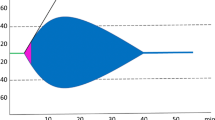Abstract
Traumatic injuries are a considerable public health burden with significant personal and social costs. Hemorrhage is responsible for a third of in-hospital trauma deaths and contributes to deaths due to multiorgan failure [1].
Access this chapter
Tax calculation will be finalised at checkout
Purchases are for personal use only
Similar content being viewed by others
References
Sauaia A, Moore FA, Moore EE, et al. Epidemiology of trauma deaths: a reassessment. J Trauma. 1995;38:185–93.
Brohi K, Cohen MJ, Ganter MT, et al. Acute coagulopathy of trauma: hypoperfusion induces systemic anticoagulation and hyperfibrinolysis. J Trauma. 2008;64:1211–7.
Henry DA, Carless PA, Moxey AJ, O’Connel D, Stokes BJ, Fergusson DA, Ker K. Anti-fibrinolytic use for minimising perioperative allogeneic blood transfusion. Cochrane Database Syst Rev. 2011;19(1):CD001886.
The CRASH-2 Collaborators. Effects of TXA on death, vascular occlusive events, and blood transfusion in trauma patients with significant hemorrhage (CRASH-2): a randomised, placebo-controlled trial. Lancet. 2010;376:23–32.
The CRASH-2 Collaborators. The importance of early treatment with TXA in bleeding trauma patients: an exploratory analysis of the CRASH-2 randomised controlled trial. Lancet. 2011;377:1096–101.
Ker K, Prieto-Merino D, Roberts I. Systematic review, meta-analysis and meta regression of the effect of tranexamic acid on surgical blood loss. Br J Surg. 2013;100:1271–9.
Perel P, Ker K, Morales Uribe CH, Roberts I. Tranexamic acid for reducing mortality in emergency and urgent surgery. Cochrane Database Syst Rev. 2013;31(1):CD010245.
Ker K, Edwards P, Perel P, Shakur H, Roberts I. Effect of tranexamic acid on surgical bleeding: systematic review and cumulative meta-analysis. BMJ. 2012;344:e30542.
Roberts I, Shakur H, Ker K, Coats T, CRASH-2 Trial Collaborators. Antifibrinolytic drugs for acute traumatic injury. Cochrane Database Syst Rev. 2012;1:CD004896.
Roberts I, Perel P, Prieto-Merino D, Shakur H, Coats T, Hunt BJ, Lecky F, Brohi K, Willwt K. Effect of tranexamic acid on mortality in patients with traumatic bleeding: prespecified analysis of data from randomised controlled trial. BMJ. 2012;345:e5839.
Godier A, Roberts I, Hunt BJ. Tranexamic acid: less bleeding and less thrombosis? Crit Care. 2012;16(3):135.
The CRASH-3 Trial Collaborators. Effects of tranexamic acid on death, disability, vascular occlusive events and other morbidities in patients with acute traumatic brain injury (CRASH-3): a randomized, placebo-controlled trial. Lancet. 2019;394(10210):1713–23.
Stief TW. Drug-induced thrombin generation: the breakthrough. Hemost Lab. 2010;3:3–6.
Dirkmann D, Gorlinger K, Gisbertz C, et al. Factor XIII and TXA but not recombinant factor VIIa attenuate tissue plasminogen activator-induced hyperfibrinolysis in human whole blood. Anesth Analg. 2012;114(6):1182–8.
Sawamura A, Hayakawa M, Gando S, et al. Disseminated intravascular coagulation with a fibrinolytic phenotype at an early phase of trauma predicts mortality. Thromb Res. 2009;1214:608–13.
Eriksson O, Kjellman H, Pilbrant A, Schannong M. Pharmacokinetics of TXA after intravenous administration to normal volunteers. Eur J Clin Pharmacol. 1974;7:375–80.
Faraoni D, Goobie SM. The efficacy of Antifibrinolytic drugs in children undergoing noncardiac surgery: a systematic review of the literature. Anesth Analg. 2014;118:628–36.
Morrison JJ, Dubose JJ, Rasmussen TE, Midwinter MJ. Military application of tranexamic acid in trauma emergency resuscitation (MATTERs) study. Arch Surg. 2012;147(2):113–9.
Spahn DR, Bouillon B, Cerny V, Coats TJ, Duranteau J, Fernández-Mondéjar E, Filipescu D, Hunt BJ, Komadina R, Nardi G, Neugebauer E, Ozier Y, Riddez L, Schultz A, Vincent J-L, Rossaint R. Management of bleeding and coagulopathy following major trauma: an updated European Guideline. Spahn et al. Critical Care. 2013;17:R76. http://ccforum.com/content/17/2/R76
National Institute for Health and Clinical Excellence. Major trauma: assessment and initial management NICE guideline [NG39]. Published date: 17 February 2016.
I Roberts, T Kawahara. Proposal for the inclusion of TXA (antifibrinolytic – lysine analogue) in the WHO model list of essential medicines. In: 18th expert committee on the selection and use of essential medicines. Published on 2 June 2010.
Author information
Authors and Affiliations
Corresponding author
Editor information
Editors and Affiliations
Rights and permissions
Copyright information
© 2021 Springer Nature Switzerland AG
About this chapter
Cite this chapter
Volpi, A., Grossi, S., Mazzani, R. (2021). Tranexamic Acid in Trauma Patients. In: Landoni, G., Baiardo Redaelli, M., Sartini, C., Zangrillo, A., Bellomo, R. (eds) Reducing Mortality in Critically Ill Patients. Springer, Cham. https://doi.org/10.1007/978-3-030-71917-3_14
Download citation
DOI: https://doi.org/10.1007/978-3-030-71917-3_14
Published:
Publisher Name: Springer, Cham
Print ISBN: 978-3-030-71916-6
Online ISBN: 978-3-030-71917-3
eBook Packages: MedicineMedicine (R0)




